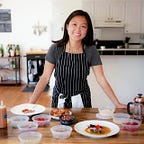5 Plating Tips to Beautify Your Next Dish
--
Plating is an ongoing lesson. There’s always more to learn, more to play with, more inspiration to gather from the talented chefs around the world. I like to follow Instagram hashtags like #theartofplating #gastroart #gourmetartistry for lots of fodder, new ideas, and bursts of incredulous “the heck did he/she do that?”. But everyday plating doesn’t mean you have to spend eons tweezing one dish — beautiful food can come out of any kitchen with a little extra attention to detail. We ‘omnomnivores’ very much eat with our eyes, so prettying up even your own relaxed weeknight dinner elevates the occasion to feel more like a splurge. I’ve put together some introductory tips that won’t add too much time in the kitchen (so you can focus on eating!) but yields big results.
1. Use a larger plate.
There’s a reason restaurants always seem to set down these giant white plates in front of you. The negative space (“white space”) between the food and the plate should be balanced appropriately — there is usually more white space than there is food. That way, the dish doesn’t look “cluttered” and it makes the food really stand out. This is somewhat counterintuitive to most, so I recommend starting with 2 sizes up in what you think you need for the plate, plating from the center, and getting familiar with what ample white space really looks like.
2. Contrast is key
Contrast means a lot more than color. Start with different color pallets — bright green vegetables, a rich red puree, jet black accents, etc. — and then think about textures and height. This photo here has a variety of raw and cooked vegetables with poached shrimp, ginger-carrot puree, and little cucumber “pearls” for something round. While smooth textures like purees and sauces are always very beautiful, a rough-chop cole slaw can also be very appealing when presented in a dignified way. I love to use nuts, crisps, and larger herbs (i.e. these fennel fronds) on dishes too! Don’t be afraid to stack items on top of each other to bring the eye upwards from the plate.
3. Cluster — or don’t
A definitive touch works wonders on a plate. If you like to cluster your foods together, do it! If you don’t like that look, keep them squarely apart (a lot of white space between them). Just make sure to stray from the gray zone when you try to do both and your plate ends up with a lot of components spread out in 1 flat layer.
4. Rule of odd numbers
Generally speaking, odd numbers look better than even numbers on a plate. Have you wondered why a plate would have 7 scallops for ceviche but not 8? How the heck do you split 7 things? Well…now you know. Why is that? I think it’s because it gives some movement to the plate instead of splitting it with such symmetry. That being said, very symmetrical plates like this one can also be very pleasing —but symmetry means any (and all) little outliers are much more noticeable to the eye. Ultimately, you need to pick one way or the other and go with it!
5. Technique is the foundation of plating
No matter how many tips are here, the most important thing is technique while you’re making the food. If you want silky-smooth sauces, they need to be strained through a fine-mesh strainer. If you want beautiful filets, they need to be cooked properly. If you want to create ribbons or circles from root vegetables, they need to be mandolined precisely. If you want bright greens for your plate, they need to be blanched and shocked. Put your heart into learning the techniques and your plate will reward you over and over again — and not just for the camera.
